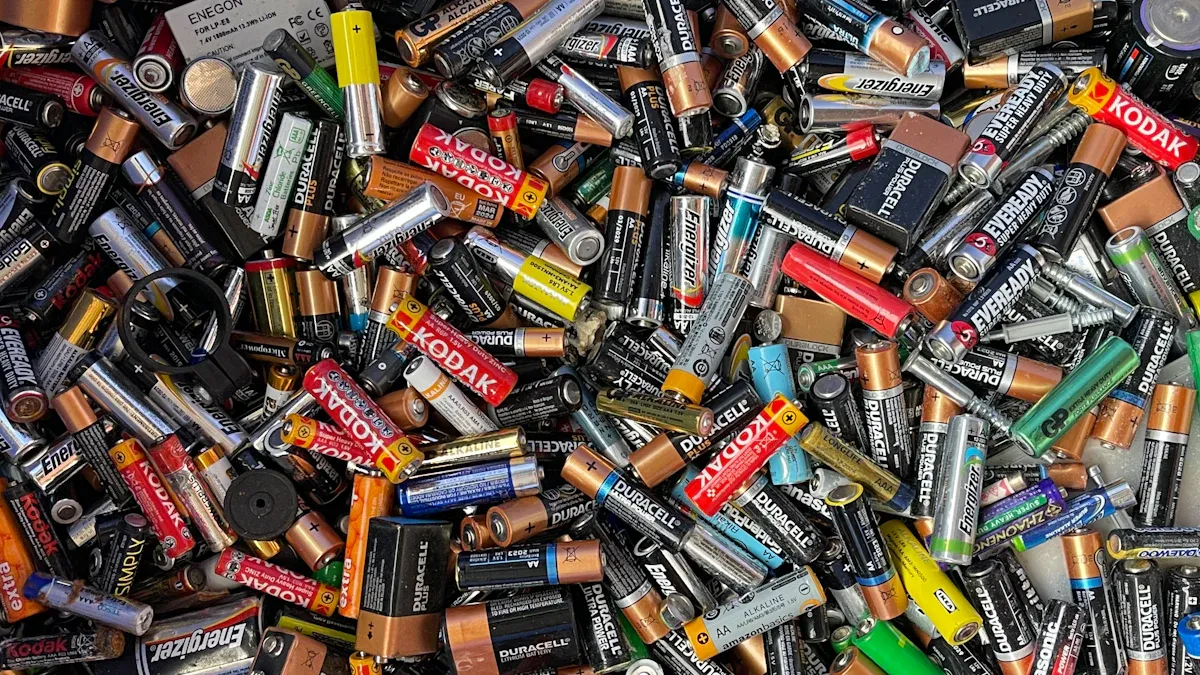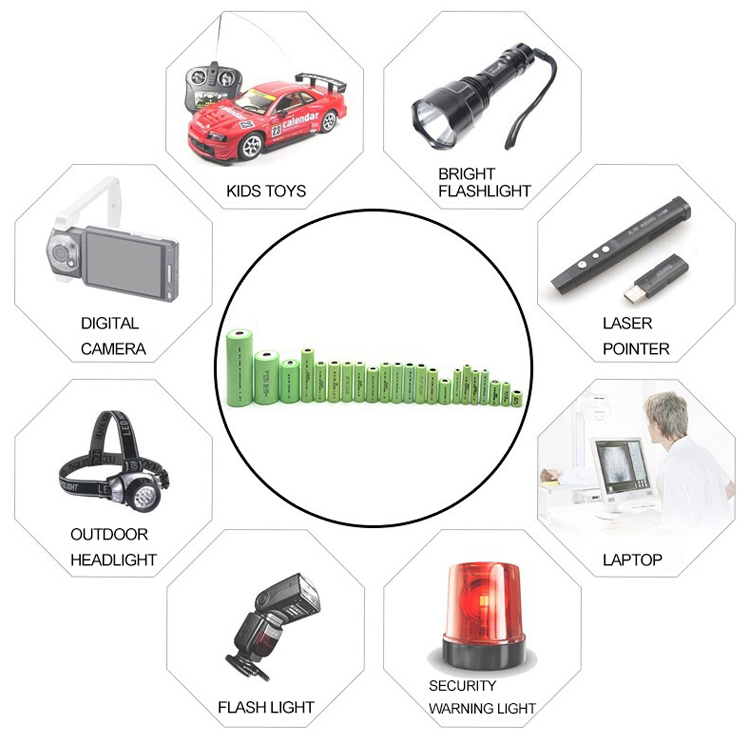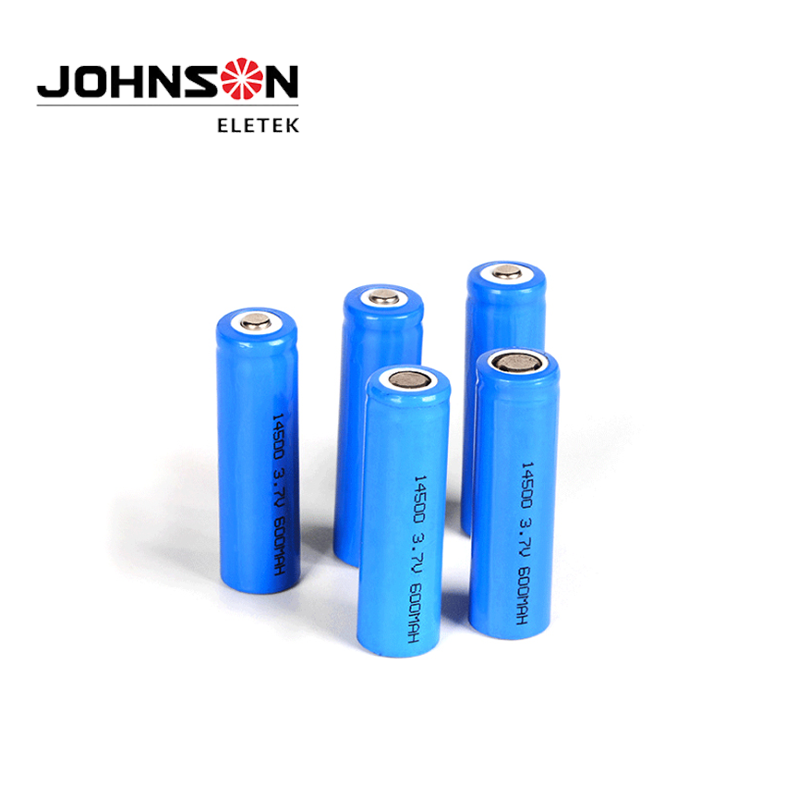Battery life plays a pivotal role in industrial applications, influencing efficiency, cost, and sustainability. Industries demand reliable energy solutions as global trends shift toward electrification. For example:
- The automotive battery market is projected to grow from USD 94.5 billion in 2024 to USD 237.28 billion by 2029.
- The European Union aims to reduce greenhouse gas emissions by 55% by 2030.
- China targets 25% of new car sales to be electric by 2025.
When comparing NiMH vs Lithium batteries, each offers unique advantages. While NiMH batteries excel in handling high current loads, Lithium-ion Battery technology delivers superior energy density and longevity. Determining the better option depends on the specific industrial application, whether powering a Ni-CD Rechargeable Battery system or supporting heavy machinery.
Key Takeaways
- NiMH batteries are dependable and cheap, good for steady power needs.
- Lithium-ion batteries store more energy and charge quickly, great for small, powerful devices.
- Think about the environment and safety when picking NiMH or Lithium batteries for work use.
NiMH vs Lithium: Overview of Battery Types

Key Characteristics of NiMH Batteries
Nickel-Metal Hydride (NiMH) batteries are widely recognized for their reliability and durability. These batteries operate with a nominal voltage of 1.25 volts per cell, making them suitable for applications requiring consistent power output. Industries often use NiMH batteries in hybrid electric vehicles and energy storage systems due to their ability to handle high current loads.
One of the standout features of NiMH batteries is their capacity to capture energy during braking, which enhances energy efficiency in automotive applications. Additionally, they contribute to reducing emissions when integrated into vehicles, aligning with global sustainability goals. NiMH batteries are also known for their robust performance in moderate temperature ranges, making them a dependable choice for various industrial environments.
Key Characteristics of Lithium Batteries
Lithium-ion batteries have revolutionized energy storage with their superior energy density and lightweight design. These batteries typically operate at a higher voltage of 3.7 volts per cell, enabling them to deliver more power in compact sizes. Their versatility makes them ideal for renewable energy storage and grid stabilization, where efficient energy management is critical.
Lithium batteries excel in storing excess energy from renewable sources like solar and wind, supporting the transition to cleaner energy systems. Their long cycle life and high efficiency further enhance their appeal for industrial applications. Moreover, lithium-ion technology performs well across a wide temperature range, ensuring consistent operation in extreme conditions.
| Feature | NiMH Batteries | Lithium-Ion Batteries |
|---|---|---|
| Voltage per cell | 1.25V | Varies (typically 3.7V) |
| Applications | Hybrid electric vehicles, energy storage | Renewable energy storage, grid stabilization |
| Energy capture | Captures energy during braking | Ideal for storing excess energy from renewables |
| Environmental impact | Reduces emissions when used in vehicles | Supports renewable energy integration |
Both NiMH and lithium batteries offer unique advantages, making the choice between them application-specific. Understanding these characteristics helps industries determine the best fit for their needs when comparing nimh vs lithium technologies.
NiMH vs Lithium: Key Comparison Factors
Energy Density and Power Output
Energy density and power output are critical factors in determining battery performance for industrial applications. Lithium-ion batteries outperform NiMH batteries in energy density, offering a range of 100-300 Wh/kg compared to NiMH’s 55-110 Wh/kg. This makes lithium batteries more suitable for compact applications where space and weight are limited, such as portable medical devices or drones. Additionally, lithium batteries excel in power density, delivering 500-5000 W/kg, whereas NiMH batteries provide only 100-500 W/kg. This higher power density enables lithium batteries to support high-performance requirements, such as those in electric vehicles and heavy machinery.
NiMH batteries, however, maintain a steady power output and are less prone to sudden voltage drops. This reliability makes them a dependable choice for applications requiring consistent energy delivery over time. While lithium batteries dominate in energy and power density, the choice between nimh vs lithium depends on the specific energy demands of the industrial application.
Cycle Life and Longevity
The longevity of a battery significantly impacts its cost-effectiveness and sustainability. Lithium-ion batteries generally offer a longer cycle life, with approximately 700-950 cycles, compared to NiMH batteries, which range from 500-800 cycles. In optimal conditions, lithium batteries can even achieve tens of thousands of cycles, making them a preferred choice for applications requiring frequent charging and discharging, such as renewable energy storage systems.
| Battery Type | Cycle Life (Approx.) |
|---|---|
| NiMH | 500 – 800 |
| Lithium | 700 – 950 |
NiMH batteries, while having a shorter cycle life, are known for their durability and ability to withstand moderate environmental stress. This makes them suitable for applications where longevity is less critical but reliability is paramount. Industries must weigh the trade-off between initial cost and long-term performance when selecting between these two battery types.
Charging Time and Efficiency
Charging time and efficiency are crucial for industries that rely on quick turnaround times. Lithium-ion batteries charge significantly faster than NiMH batteries. They can reach 80% capacity in under an hour, whereas NiMH batteries typically require 4-6 hours for a full charge. This rapid charging capability of lithium batteries enhances operational efficiency, especially in industries like logistics and transportation, where downtime must be minimized.
| Metric | NiMH Batteries | Lithium-Ion Batteries |
|---|---|---|
| Charging Time | 4–6 hours to fully charge | 80% charge in under 1 hour |
| Cycle Life | Over 1,000 cycles at 80% DOD | Tens of thousands of cycles in optimal conditions |
| Self-Discharge Rate | Loses ~20% charge monthly | Loses 5-10% charge monthly |
NiMH batteries, however, exhibit higher self-discharge rates, losing approximately 20% of their charge monthly, compared to lithium batteries, which lose only 5-10%. This difference in efficiency further solidifies lithium batteries as the superior choice for applications requiring frequent and efficient charging.
Performance in Extreme Conditions
Industrial environments often expose batteries to extreme temperatures, making thermal performance a critical consideration. NiMH batteries operate effectively within a wider temperature range of -20°C to 60°C, making them suitable for outdoor applications or environments with fluctuating temperatures. Lithium-ion batteries, while efficient, face challenges in extreme cold, which can reduce their performance and lifespan.
NiMH batteries also exhibit greater resistance to thermal runaway, a condition where excessive heat leads to battery failure. This safety feature makes them a reliable choice for applications in harsh environments. However, lithium batteries continue to dominate in controlled industrial settings where temperature management systems are in place.
Cost and Affordability
Cost plays a pivotal role in battery selection for industrial applications. NiMH batteries are generally more affordable upfront, making them an attractive option for budget-conscious industries. However, lithium-ion batteries, despite their higher initial cost, offer better long-term value due to their extended cycle life, higher energy efficiency, and reduced maintenance requirements.
- Energy Density: Lithium batteries provide higher capacity, justifying their cost for high-performance applications.
- Cycle Life: Longer lifespan reduces replacement frequency, saving costs over time.
- Charging Time: Faster charging minimizes downtime, enhancing productivity.
Industries must evaluate their budget constraints and operational needs to determine the most cost-effective solution. While NiMH batteries may suit short-term projects, lithium batteries often prove more economical in the long run.
NiMH vs Lithium: Application-Specific Suitability
Medical Devices
In the medical field, battery reliability and performance are crucial. Lithium-ion batteries dominate this sector, accounting for over 60% of the global medical battery market. They power more than 60% of portable medical devices, offering up to 500 charge cycles with over 80% capacity in devices like infusion pumps. Their high energy density and long cycle life make them ideal for medical applications, ensuring devices remain operational during critical times. Compliance with industry standards, such as ANSI/AAMI ES 60601-1, further underscores their suitability. NiMH batteries, while less prevalent, offer cost-effectiveness and lower toxicity, making them suitable for backup equipment.
Renewable Energy Storage
The renewable energy sector increasingly relies on efficient energy storage solutions. Lithium-ion batteries excel in this area due to their high energy density and ability to store excess energy from renewable sources like solar and wind. They help stabilize electrical grids, supporting the transition to cleaner energy systems. NiMH batteries also find use in off-grid solar power systems, providing reliable energy storage. Their affordability and moderate energy density make them a viable option for smaller-scale renewable projects.
Heavy Machinery and Equipment
Industrial operations demand robust and reliable power sources. Lithium-ion batteries meet these demands with high power delivery, robust construction, and longevity. They endure harsh environments, providing reliable power over extended periods and reducing downtime. NiMH batteries, while less powerful, offer steady power output and are less prone to overheating. This makes them suitable for applications where consistent energy delivery is essential.
- High power delivery to meet industrial machinery demands.
- Robust construction to endure harsh environments.
- Longevity for reliable power over extended periods, reducing downtime.
Other Industrial Applications
In various other industrial applications, the choice between nimh vs lithium depends on specific needs. NiMH batteries are used in hybrid electric vehicles (HEVs) for energy storage, capturing energy during braking and supplying it during acceleration. They are more affordable and less prone to overheating compared to lithium-ion batteries. In portable electronics, NiMH batteries remain popular for devices like digital cameras and handheld tools due to their rechargeability and reliability in extreme temperatures. Conversely, lithium-ion batteries dominate the electric vehicle market due to their high energy density and long cycle life. They also play a crucial role in grid storage systems, storing excess energy from renewable sources and helping stabilize electrical grids.
| Industrial Sector | Case Study Description |
|---|---|
| Automotive | Consulting for electric vehicles (EV) and hybrid electric vehicles (HEV) testing, including development of test protocols for NiMH and Li-ion chemistries. |
| Aerospace | Assessment of high power lithium-ion battery technologies for aerospace applications, including evaluations of thermal and electric management systems. |
| Military | Investigation into environmentally friendly alternatives to NiCd batteries for military applications, focusing on performance and logistics. |
| Telecommunications | Support for a global supplier in expanding UPS products, evaluating potential battery products based on performance and availability. |
| Consumer Electronics | Analysis of battery failures, including a case involving a NiMH battery fire in a hybrid electric city bus, providing insights into safety and performance issues. |
The choice between nimh vs lithium batteries in industrial applications hinges on specific requirements, including energy density, cost, and environmental conditions.
NiMH vs Lithium: Environmental and Safety Considerations
Environmental Impact of NiMH Batteries
NiMH batteries offer a moderate environmental footprint compared to other battery types. They contain fewer toxic materials than nickel-cadmium (NiCd) batteries, making them less hazardous to dispose of. However, their production involves mining nickel and rare earth metals, which can lead to habitat destruction and pollution. Recycling programs for NiMH batteries help mitigate these impacts by recovering valuable materials and reducing landfill waste. Industries that prioritize sustainability often choose NiMH batteries for their lower toxicity and recyclability.
Environmental Impact of Lithium Batteries
Lithium-ion batteries have a higher energy density but come with significant environmental challenges. Extracting lithium and cobalt, key components, requires intensive mining processes that can harm ecosystems and deplete water resources. Additionally, improper disposal of lithium batteries can release harmful chemicals into the environment. Despite these concerns, advancements in recycling technologies aim to recover materials like lithium and cobalt, reducing the need for new mining operations. Lithium batteries also support renewable energy systems, indirectly contributing to environmental sustainability.
Safety Features and Risks of NiMH
NiMH batteries are known for their safety and reliability. They exhibit a lower risk of thermal runaway, a condition where excessive heat causes battery failure. This makes them suitable for applications in harsh environments. However, overcharging or improper handling can lead to leakage of electrolyte, which may cause minor safety concerns. Proper storage and usage guidelines minimize these risks, ensuring safe operation in industrial settings.
Safety Features and Risks of Lithium
Lithium-ion batteries offer advanced safety features, including built-in protection circuits to prevent overcharging and overheating. However, they are more prone to thermal runaway, especially under extreme conditions. This risk necessitates strict temperature management systems in industrial applications. Manufacturers continuously improve lithium battery designs to enhance safety, making them a reliable choice for controlled environments. Their lightweight and high energy density further solidify their position in industries requiring portable power solutions.
Practical Recommendations for Industrial Applications
Factors to Consider When Choosing Between NiMH and Lithium
Selecting the right battery type for industrial applications requires careful evaluation of several factors. Each battery type offers unique advantages, making it essential to align the choice with specific operational needs. Below are the key considerations:
- Energy Requirements: Industries must assess the energy density and power output needed for their applications. Lithium-ion batteries provide higher energy density, making them suitable for compact and high-performance systems. NiMH batteries, on the other hand, deliver consistent power output, ideal for applications requiring steady energy delivery.
- Operating Environment: The environmental conditions in which the battery will operate play a crucial role. NiMH batteries perform reliably in moderate to extreme temperatures, while lithium-ion batteries excel in controlled environments with proper temperature management systems.
- Budget Constraints: Initial costs and long-term value must be weighed. NiMH batteries are more affordable upfront, making them a cost-effective choice for short-term projects. Lithium-ion batteries, despite their higher initial cost, offer better long-term value due to their extended cycle life and efficiency.
- Charging and Downtime: Industries with tight operational schedules should prioritize batteries with faster charging times. Lithium-ion batteries charge significantly faster than NiMH batteries, reducing downtime and enhancing productivity.
- Safety and Reliability: Safety features and risks must be considered, especially in industries with harsh operating conditions. NiMH batteries exhibit lower risks of thermal runaway, while lithium-ion batteries require advanced safety systems to mitigate overheating risks.
- Environmental Impact: Sustainability goals may influence the choice. NiMH batteries contain fewer toxic materials, making them easier to recycle. Lithium-ion batteries, while supporting renewable energy systems, require responsible disposal to minimize environmental harm.
By evaluating these factors, industries can make informed decisions that align with their operational goals and sustainability objectives.
NiMH and Lithium batteries each offer distinct advantages for industrial applications. NiMH batteries provide steady power and affordability, while Lithium batteries excel in energy density, longevity, and efficiency. Industries should evaluate their specific operational needs to determine the best fit. Aligning battery choice with application requirements ensures optimal performance and cost-effectiveness.
FAQ
What are the main differences between NiMH and Lithium batteries?
NiMH batteries offer steady power and affordability, while Lithium batteries provide higher energy density, faster charging, and longer cycle life. The choice depends on application-specific requirements.
Which battery type is better for extreme temperatures?
NiMH batteries perform better in extreme temperatures, operating reliably between -20°C and 60°C. Lithium batteries require temperature management systems for optimal performance in harsh conditions.
How does battery recycling impact the environment?
Recycling reduces environmental harm by recovering valuable materials like nickel and lithium. It minimizes landfill waste and supports sustainability goals in industrial applications.
Post time: May-16-2025






